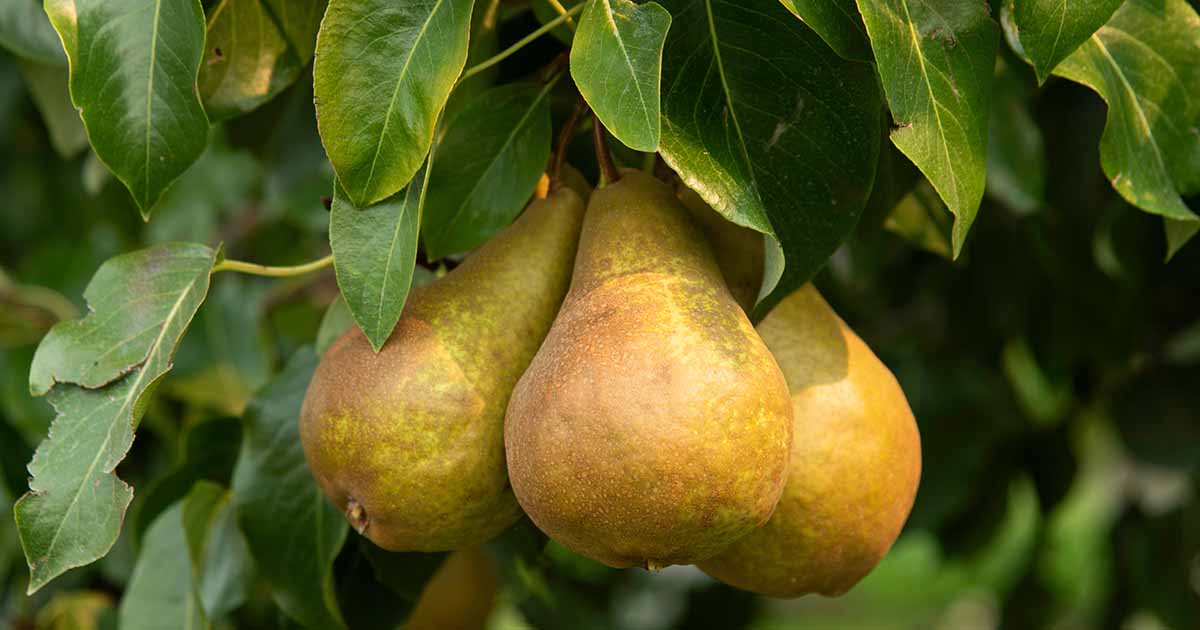Bake it in the oven, sprinkle on some cinnamon and add a dollop of whipped cream and you’re in for a healthy treat that tastes like something sinfully decadent.
‘Ayers’ was discovered by grower O.H. Ayer in Sibly, Kansas in 1880 as a chance seedling.
2. Bosc
The cinnamon brown, russetted skin and iconic shape of P. communis ‘Bosc’ has made it the star of many drawings and paintings.
It tastes delicious, too. Starting in late September, the fruits start ripening with ivory-colored, crisp, juicy flesh.


‘Bosc’
The first ‘Bosc’ found its way from Europe to the US in 1832. It’s not clear where it originated in Europe, but there are lots of theories. Regardless, it’s a beautiful option for cold climates.
You can find ‘Bosc’ available in #5 containers at Nature Hills Nursery.
Learn how to grow ‘Bosc’ pears here.
3. Clapp’s Favorite
It’s not just Clapp who loves this tree best: ‘Clapp’s Favorite’ (P. communis) is extremely popular and pretty much anyone who grows it falls in love.


This vigorous, adaptable tree produces beautiful yellow pears with a hint of blush red, wrapped around sweet, creamy flesh.
The medium to large fruits are ready early and the tree will treat you to beautiful fall colors when the foliage turns purple, red, and gold.
William Clapp and his sons Thaddeus, Frederick, and Lemuel developed ‘Clapp’s Favorite’ in Dorchester, Massachusetts during the 1800s and it has remained in production thanks to its popularity ever since.


‘Clapp’s Favorite’
You can find ‘Clapp’s Favorite’ in #2 containers available at Nature Hills Nursery.
4. Early Gold
‘Early Gold’ is a Russian (P. ussuriensis) hybrid that doesn’t mind the chilly climate in Zone 3 and up.
It’s early maturing, ready in late August, with large, golden fruits that have white interiors. When mature, the flesh has a sweet, melting flavor and texture.
While it’s self-pollinating, you’ll achieve much larger yields with a pollinator planted close by.
It’s also an excellent pollinator for other cultivars, with heaps and heaps of huge white blossoms in the spring.
5. Flemish Beauty
In Zones 4 to 8, fantastic P. communis ‘Flemish Beauty’ grows medium to large fruits with a nice rounded shape and a blush hue over yellow skin.


It’s one of the most cold hardy of the European pears, and will survive just fine down to -40°F.
Originally called ‘Fondante de Boise’ or “Sweetmeat of the Woods,” this cultivar has extremely creamy flesh that melts in your mouth with its sweet, floral flavor that’s ready for harvesting in late summer.
6. Golden Spice
If you like your pears with a bit of spice, ‘Golden Spice’ is your tree.
Brought to us by the University of Minnesota in 1949, the fruits are tart and spicy, wrapped in a blush and golden green skin.


‘Golden Spice’
This Russian hybrid is fireblight resistant and reliably hardy down to Zone 3 but will even survive in Zone 2b if you put it in a protected spot.
The fruits are ready mid-August and are a delight. You can find ‘Golden Spice’ available at Nature Hills Nursery.
7. Harrow Delight
‘Harrow Delight’ is a popular European pear option in the Pacific Northwest, which isn’t exactly known for its frigid winters.
But that just speaks to its adaptability, because it’s also a regular sight in northern climates down to Zone 3b.

